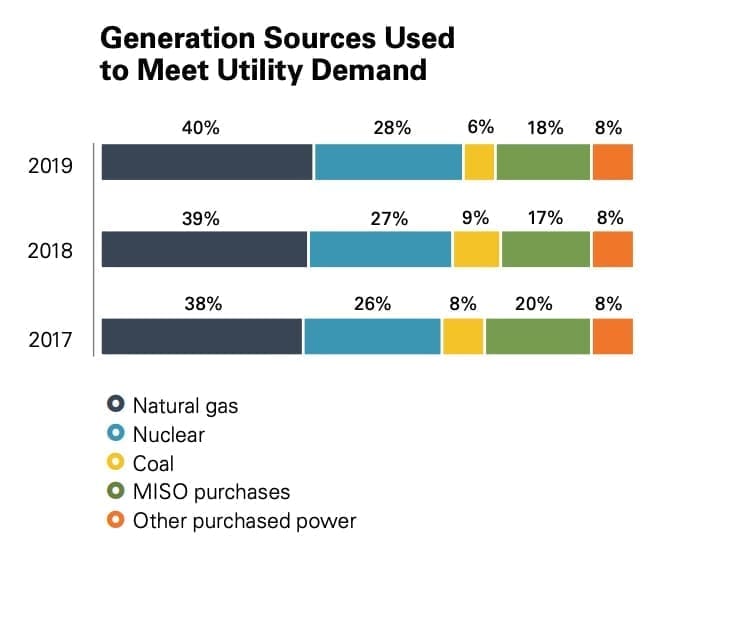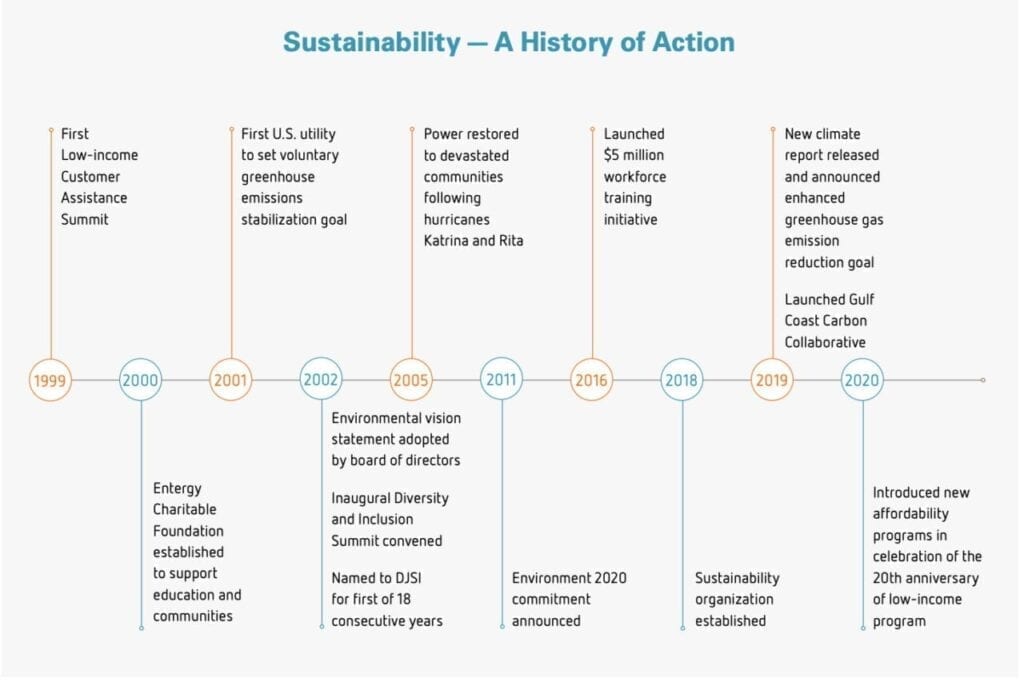Entergy Moves Heavily on Hydrogen for Gas Turbines, Nuclear
Entergy Corp., an integrated energy company with a 30-GW power generating fleet, took a bold step toward decarbonization on Sept. 23, announcing it would join forces with Mitsubishi Power to integrate green hydrogen into utility businesses in Arkansas, Louisiana, Mississippi, and Texas.
Entergy will focus on developing hydrogen-capable combined cycle gas turbine (CCGT) facilities and related infrastructure to enable hydrogen production, storage, and transportation. Entergy and Mitsubishi Power also said they would create “nuclear-supplied electrolysis facilities with energy storage,” as well as develop utility-scale battery storage systems.
Some of these solutions will integrate Mitsubishi Power’s freshly announced standardized hydrogen packages, Hydaptive and Hystore. The Hystore package is inspired by Mitsubishi Power’s ongoing projects to outfit the 840-MW Intermountain Power Project (IPP) in Millard County, Utah, with hydrogen–capable turbines, as well as the company’s massive Advanced Clean Energy Storage (ACES) project, a project that promises to store up to 1 GW of renewable energy as hydrogen gas (and is strategically located near the new IPP facility). The Hydaptive package is focused on site integration, spanning the electrolyzers to the gas turbines.
Earlier this month, Mitsubishi Power announced it bagged lucrative contracts for Hydaptive with three major gas-fired power projects—a total of 2.1 GW—in eastern competitive markets that are slated to come online between 2023 and 2025. The plants, which represent a total investment of $3 billion, include Balico’s 1,600-MW Chickahominy Power Project in Virginia; EmberClear’s 1,084-MW Harrison Power Project in Cadiz, Ohio; and Danskammer Energy’s 600-MW plant in Newburgh, New York.
In tandem, Mitsubishi Power is also ramping up its battery storage portfolio. Last month it announced a contract with Key Capture Energy (KCE) to build three utility-scale lithium-ion battery storage systems totaling 200 MW within the Electric Reliability Council of Texas’s (ERCOT’s) footprint. KCE, one of ERCOT’s largest standalone battery storage project developers, has a notable 1,500 MW of standalone battery storage capacity in its pipeline across the U.S., much of it backed with offtake contracts with investment entities.
Entergy: Sustainability Is a Responsibility and an Opportunity
For Entergy Corp., joining forces with Mitsubishi Power is another major boost toward long-standing sustainability goals. At the end of 2019, Entergy owned and operated a diverse fleet comprising 2.4 GW of coal power, 7 GW of “legacy” gas power, and 8.3 GW of combined cycle gas turbine (CCGT) and combustion turbine capacity. It also owns or leases 75 MW of renewables, most which is hydropower and solar. And it has a substantial 8 GW nuclear fleet comprising five units: Arkansas Nuclear One units 1 and 2, Grand Gulf Nuclear Station, River Bend Station, and Waterford 3 Steam Electric Station. The Nuclear Regulatory Commission has renewed the operating licenses for all nuclear units in Entergy’s utility fleet to beyond 2030.

The company delivers power to 2.9 million utility customers in Arkansas, Louisiana, Mississippi, and Texas through 16,000 circuit miles of high-voltage transmission, and 105,000 circuit miles of distribution lines. The company brought in $10.9 billion in revenues from all its assets in 2019.
As Entergy CEO and Chairman of the Board Leo Denault noted in the company’s May 2020–released 2019 Integrated Report, Entergy’s sustainability efforts are rooted in its 2002-adopted “visionary statement” to commit to a environmentally, socially, and economically sustainable business. The strategy’s primary objective is to address risks and cater to “four key stakeholders”: customers, employees, communities, and owners, he said. Last year, the company further intensified efforts to address climate risks by setting a new commitment to reduce its carbon emissions rate to 50% below year-2000 levels by 2030.
“As validation of our long-term commitment to sustainability, in 2019 Entergy was once again named to the Dow Jones Sustainability Index. We are the only U.S. electric utility to be included on the DJSI for 18 consecutive years. We earned perfect scores in climate strategy, corporate citizenship and philanthropy, water-related risks, materiality, and policy influence,” the company said in its Integrated Report.

The latest alliance with Mitsubishi Power stems from the company’s acknowledgement that its environmental stewardship is tightly linked to its business strategy are linked—and that the company views decarbonization “not as a choice, but as a responsibility and an opportunity.” Because it operates in a region with such a large concentration of existing industrial activity and strong industrial growth, it is “uniquely positioned to partner with customers in other industries such as manufacturing, ports, and transportation to help them reduce their own emissions by electrifying their energy needs and operations,” the company notes.
“New technologies and innovative solutions to the challenges posed by climate change present opportunities for us to significantly decrease carbon emissions from our generation portfolio. We are pleased to welcome Mitsubishi Power as a partner in developing strategies to integrate these new technologies and solutions that support us achieving our environmental commitments,” said Paul Hinnenkamp, Entergy’s executive vice president and chief operating officer, on Wednesday.
Optionality Makes Hydrogen Attractive
However, how soon Entergy will implement hydrogen solutions on wide-scale remains uncertain. The first dedicated hydrogen-ready project it may build is the Orange County Power Station in Southeast Texas, a proposed combined cycle gas turbine project Entergy Texas has been developing with Mitsubishi Power.
“The preliminary design for this project provides the capability to power the station with 70% gas and 30% hydrogen by volume upon commercial operations,” Entergy told POWER on Wednesday. “If our self-build proposal is selected from the Texas [request for proposals] and approved by our regulator, we expect to finalize that design as well as designing the station for eventual transition to 100% hydrogen-powered once hydrogen technology and infrastructure are established.”
However, “there are other similar opportunities being explored for future power generation, and projects are being explored for the generation of green hydrogen along with infrastructure for transport and storage,” it noted.
Asked why Entergy is exploring hydrogen as a decarbonization option when hydrogen power is still hindered by high costs and despite potential hurdles associated with its large-scale implementation, the company said it always looks for “innovation” in its power generation portfolio.
While it acknowledged that it is also exploring other technology innovations for its future portfolio—such as small modular reactors and carbon capture and storage—it underscored green hydrogen’s vast potential. “Already one of the most abundant elements on Earth, hydrogen can be used to produce, store, move and deliver usable energy in different ways,” it noted. “Hydrogen is a clean fuel that, when consumed, produces only water, electricity and heat. Hydrogen technology is increasingly playing an important role in power generation. It is one of the leading options for storing renewable energy and can be used in gas turbines to increase power system flexibility,” it said.
The company also pointed to recently built CCGT facilities, which it said “have the option to incorporate emerging and advanced technologies to enhance efficiency and reduce emissions.” These facilities—like the March 2020–opened 994-MW Lake Charles Power Station—have machines that are “configured to allow for the addition of carbon capture technologies and/or can be converted to support the use of alternative zero carbon fuel supplies like hydrogen fuel or renewable natural gas,” Entergy said.
However, “Modifications required to convert to alternative fuel sources may require approvals by our retail regulators. Review of any plans would be subject to our integrated resource planning processes,” it noted. Still, looking ahead, “We expect the next generation of combustion turbines will feature even greater optionality for hydrogen capabilities,” it said.
Are Power Company Hydrogen Alliances a Trend?
Mitsubishi Power’s drive to enable power sector decarbonization is notable for the original equipment manufacturer (OEM), which is still currently heavily invested in the gas and steam turbine markets. While its decarbonization effort may be primarily driven by an overarching strategy pushed by Mitsubishi Heavy Industries (MHI), its Tokyo-based parent company, it clearly also leverages opportunity in a market grappling to find a place for fossil-based investments over the long-term.
But it’s not the only one. Other major OEMs exploring similar opportunities include Siemens Energy and GE Power. Siemens Energy, for example, in January 2019 rolled out an ambitious roadmap to ramp up the hydrogen capability in its gas turbine models to at least 20% by 2020, and 100% by 2030—and it has already made much headway. Siemens is also spearheading the much-watched HYFLEXPOWER project, a four-year demonstration of a hydrogen power-to-power system.
GE Power, which earlier this week delivered stunning news that its steam power business would exit the new-build coal power market, has also made major headway on the hydrogen power segment. Perhaps most notably, this July, GE forged a decarbonization partnership with European energy giant Uniper—which owns 34 GW of power generating capacity, more than half of which is gas-fired.

GE is now expected to roll out a detailed decarbonization roadmap that may entail hydrogen-friendly upgrades to all GE gas turbines (a total 4 GW) and compressors at Uniper’s gas power plants and gas storage facilities across Europe in early 2021. As the company told POWER in July, the fleet-wide agreement—the first for the U.S-based conglomerate—will provide “the opportunity for a holistic decarbonization assessment across many GE technologies. That agreement, it noted, stems a relationship that “spans decades.” Uniper “has been first to adopt many of GE’s industry-leading technologies, like for example the Uniper power stations of Grain, Connah’s Quay or Enfield in the UK or the Uniper gas storage facilities in Germany like Etzel or Epe,” the companies said.
Likewise, Paul Browning, Mitsubishi Power America’s president and CEO, on Wednesday noted Mitsubishi Power had supported Entergy on three large power projects that he said “the utility executed on schedule and on budget as part of a multi-year project to modernize the power generation fleet and voluntarily reduce carbon emissions.”
Mitsubishi Power’s alliance with Entergy now paves the way for the “next phase of decarbonization,” Browning said. “At Mitsubishi Power, our mission is to provide power generation and storage solutions to our customers that enable them to affordably and reliably combat climate change and advance human prosperity. We look forward to extending our long-term collaboration with Entergy. Together, we will create a Change in Power.”
—Sonal Patel is a POWER senior associate editor (@sonalcpatel, @POWERmagazine).
Updated (Sept. 23): Adds quotes from Entergy, including details about its first possible project, and plans for future projects.